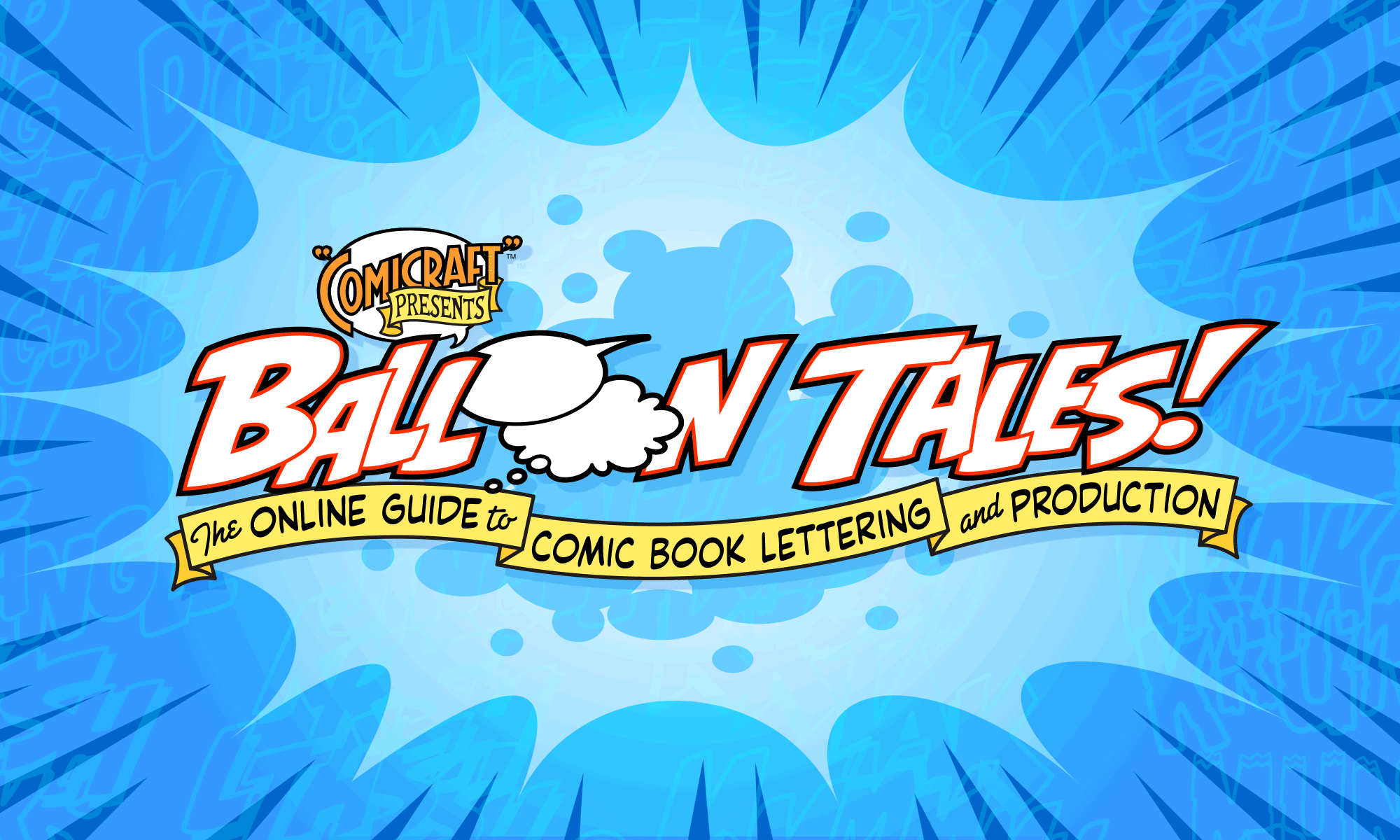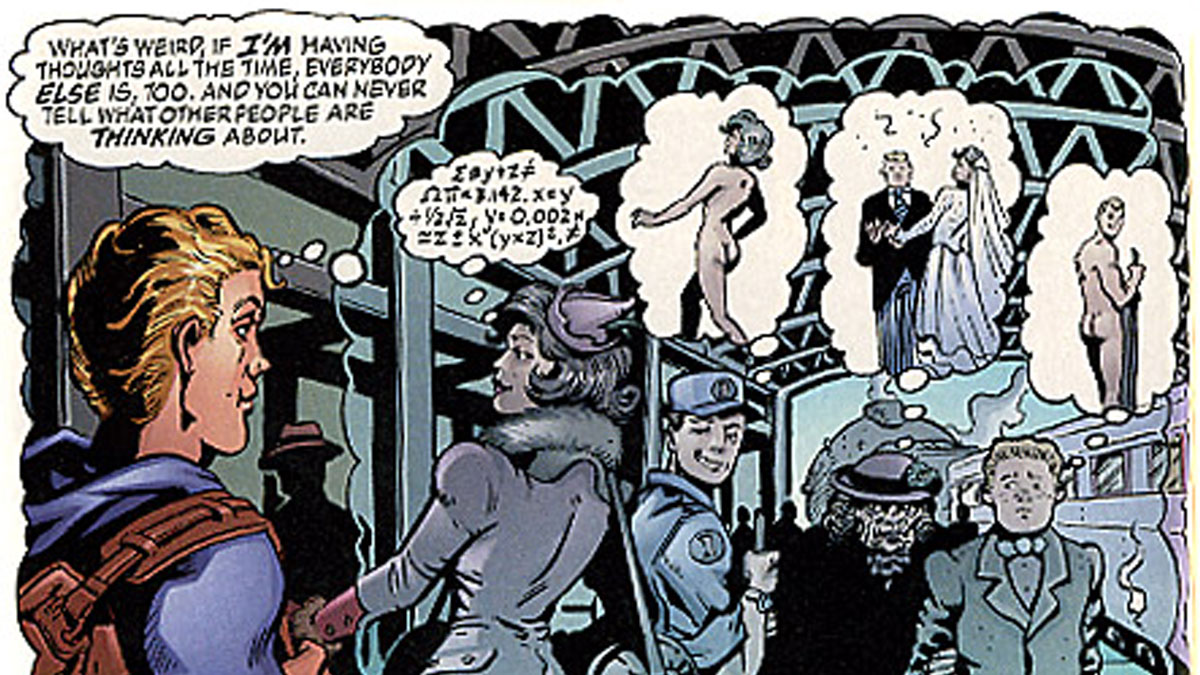A discussion on comics storytelling with Tony Isabella, Lee Nordling, Kurt Busiek, Mark Verheiden, Lovern Kindzierski, Richard Starkings, John Ostrander, Steve Leialoha, Todd Klein, Keith R.A. DeCandido, Steven Grant, Trina Robbins, Marv Wolfman, Tim Eldred, Howard Cruse, Jackie Estrada, Bob Ingersoll and Steve Lieber
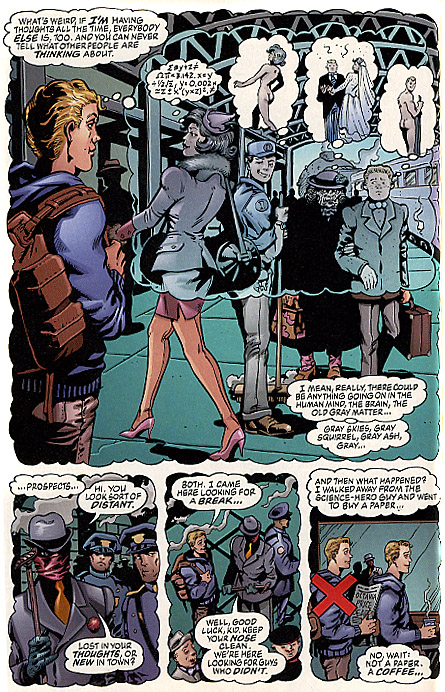
Tony Isabella: My disregard for movies and TV in general comes from their adverse effect on the comics art form and industry to which I devoted my life.
Comics try to imitate movies to such a degree that we end up doing second-rate movies in our comics instead of first-rate comics. We abandon useful storytelling tools just because they aren’t cinematic enough.
We’re into our second — maybe third — decade of too many comics creators who see the comics as mere stepping stones to Hollywood.
I enjoy movies and TV. But I don’t hold them to the same standards that I hold comics. Because I don’t think they’re as good as good comics.
I should add that, since I’m more into story than flash, I believe, a good story is a good story… and I don’t need big-screen flash for it to be a good story.
Lee Nordling: No… but scale CAN be a contributor to the way the story is supposed to be experienced. Lawrence of Arabia on TV or the big screen? No brainer. Big screen. Casablanca, Citizen Kane, Seven Samurai? Same answer.
Sure, any of those films can be enjoyed without the big screen… but that doesn’t mean that SOMETHING isn’t missing. It’s not just flash.
The comics equivalent is the use of space on a page for effect, and I remember the double-gatefold explosion at the end of Ronin. Great use of scale.
Kurt Busiek: The flip side of that — I saw THE ELECTRIC HORSEMAN in a movie theater, and thought it was lousy. Empty, shallow and dull. A few years later, it came on TV and I was much more caught up in it — watched it all the way through and liked it a lot.
The intimacy of the small screen changed the context — in the movie theater, the big vistas of western geography seemed more important, and there wasn’t a whole lot done with them, while the quiet character interplay got lost. On TV, those vista were reduced down to the idea of them more than the reality, and the idea was more important to the characters.Meanwhile the character stuff seemed to suit the small screen better — not that “character stuff” always does, just that it does here — and came forward as the heart of the story.
Context is part of storytelling.
Mark Verheiden: I’m curious, which storytelling tools are we talking about?
Lee: I assume Tony is referring to the ways the different media use time… although he could’ve been referring to the growing use of the 180 degree film rule by comics artists.
Lovern Kindzierski: What’s the 180 degree film rule?
Lee: I’m sure one of our storyboard artists can give a more precise definition… but it involves not having the camera/eye cross the 180 degree line of a circle — with the character/actor at the center — and show the character in another film cut from the opposite side, because the character/actor will seem to be looking in the opposite direction of the previous shot. It can be very disorienting in film, and first-time directors have a really tough time with this.
Richard Starkings: How about THOUGHT BALLOONS? What happened to them?
John Ostrander: I once had an editor who told me i couldn’t use thought balloons because they didn’t have them in movies. I tried pointing out that the images in movies, well, moved. Were not static. Different medium. Then the defense was that I couldn’t use them because some writers — not me, of course — used them badly. So any technique that is used badly can no longer be used? The editor just stopped listening.
Kurt: Thought balloons are almost dead, flashbacks are often discouraged,third-person narrative captions haven’t vanished, but they’ve diminished to the point of standing out where they’re used — unless they’re used so minimally that they’re the sort of thing you’d see ina Jack Ryan movie, identifying a place and maybe a time, little more.
The rationale for all of these is usually film rationale. They’re all novelistic tricks, well, thought balloons aren’t, per se, but articulating the character’s thoughts, often as directly as dialogue,is.
In addition, sound effects have been under attack from various quarters for decades now — they may be the only thing Cat Yronwode and Jim Shooter ever agreed on — and have diminished, though not disappeared.
And then there’s footnotes, not actually a narrative tool, but virtually dead as well…
Steve Leialoha: Now with Sin City we got the reverse, where Frank’s VoiceOver captions in the printed version becomes the V/O in the film version, telling us the characters thoughts.
I only like sound effects when they don’t cover up the art, or are worked in from the start — the way you see them in Walt Simonson’s work is a great example.
It seems that the trend is to eliminate all the unique things that comics can do.
Kurt: That’s my gripe with it — I don’t mind the idea of limiting technique, but I’d prefer to choose what I use, and where I choose to exercise restraint.
Eschewing thought balloons as a creative choice can result in interesting approaches. Eschewing them as a blanket formula, though,is just dumb.
And the objections to any of this stuff boil down, in most cases, to,”It’s comic-booky!”
Well, yeah. It’s a comic book. If that’s something to be embarrassed about, make a movie or write a book. If not, then let’s have access to everything comics can do, all the tools in the workshop. Because we don’t have access to everything movies can do, and we shouldn’t settle for half measures.
Rich: So, do Marvel, DC and Dark Horse editors issue edicts regarding thought balloons and sfx?
Kurt: At times, they have. I’ve been lucky enough to work with editors who’ll support thought balloons if I want to do it — and I did,occasionally, in AVENGERS — but I was also told that the EIC and publisher hated them, and looked aversely on creators that used them.
Bold words in lettering are another comics technique that’s been diminishing over time, as I expect you’ve noticed — there was a time at Marvel that Shooter set rules for how they could be used, and it was very minimal. Again, his reasoning was that it was too comic-booky.
At Valiant, he banned FX.
Rich: Have you used thought balloons in a script and been told not to?
Kurt: Not flat-out, but I’ve been told that it was a career-damaging technique. I was told flat-out not to use any flashbacks — Bill Jemas hated them, and Joe Quesada doesn’t like them much.
Rich: I do remember noting that captions became the preferred internal narrative of choice following Miller’s use of them in ELEKTRA: ASSASSIN.
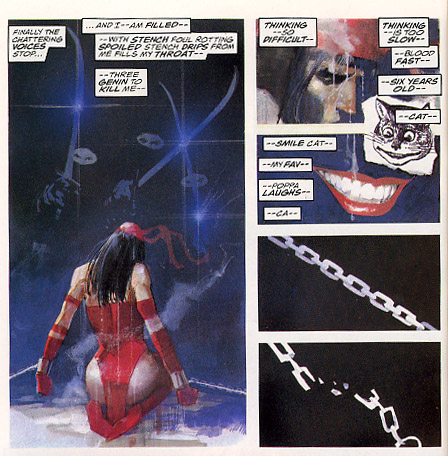
Kurt: And Miller used ’em really well, too.
But my reaction to that was, “Great, another technique that can be used well!” Unfortunately, many others thought, “Great, a replacement technique!”
They must have missed DAREDEVIL: BORN AGAIN, where Frank used third-person directed captions beautifully, too.
Todd Klein: I think Frank was a big influence regarding the decline of thought balloons, as was WATCHMEN, which also had no thought balloons I think, but both Miller and Moore were making personal style choices, not trying to set down rules for others. And perhaps it was in reaction to the overuse of thought balloons in earlier DC and Marvel books, I’m thinking especially of the Mort Weisinger era Superman books where everyone thought through every move they made in labored detail.
Keith R.A. DeCandido: It actually all kind of happened at once. He didn’t really do it on DAREDEVIL in his first run, though he had a few straight first-person-narrated stories — like the Ben Urich
issue, #179, which was published in 1982.
However, in 1986, he went crazy with it, in DARK KNIGHT, in his return toDAREDEVIL and in ELEKTRA:ASSASSIN and then again in BATMAN: YEAR ONE in1987.
Rich: Yes, Miller used the same conceit elsewhere, but I specifically remember conversations with Marvel editors Greg Wright and Dan Chichester regarding ELEKTRA: ASSASSIN and how the use of captions made thought balloons look silly. Chichester attempted something similar in one of theEpic SHADOWLINE books, with not very good results. Archie later made it a rule that writers had to use Batman’s internal narrative in LEGENDS OF THE DARK KNIGHT, which has led to some strangely omniscient first person Batman captions in the Loeb/Sale books I’ve lettered when scenes require location captions.
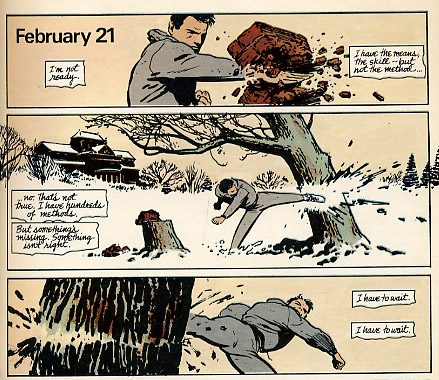
I never liked the Jim Gordon handwriting captions in YEAR ONE — sorry, Todd– partly because they were hard to read on newsprint and partly because thereafter writers were asking me for similar caption styles. There are only so many ways you can make handwriting look good in comic book captions and before long you’re going to have major problems with ascenders and descenders. Computer lettering makes it much easier to adjust this kind of thing, but when you’re in mid flow with a pen and a ‘d’ comes up against a’y’ on the line above… What? I’m getting too lettering-specific for you?
Steven Grant: As much fun as it is to credit Frank with stuff, first person captions were well established in comics prior to Frank putting pen to his first issue of DAREDEVIL — but, yes, he made full use of them in DD. I remember both Steve Englehart and Steve Gerber using them in stories in the mid-’70s, and I’m pretty sure Marv used them in TOMB OF DRACULA, and even THOSE weren’t anywhere near the first use. This is going to sound self-centered, but I know one thing that greatly influenced overuse of the”first person caption as substitute thought balloon” in the mid-80s: my use of the gimmick in the PUNISHER mini series. Now I wasn’t particularly influenced by Frank or anyone else when I used them, I just had a vision ofThe Punisher as someone who felt under no compulsion to explain himself to anyone, but he had been established as keeping a diary/war journal — which,frankly, I thought was a stupid idea; yeah, that’s smart, write down all of your transgressions and strategies so that anyone getting ahold of your book can either prosecute you or outmaneuver you — so the first person captions became essentially this running diary he kept in his head, his dislocated commentary on his situation. For a lot of editors, Frank fell into rarified territory — “sure, HE can do it, because he’s FRANK, but you’re not, so forget it” — but I was considered a low-ranking in the heirarchy of comics writers, and if >I< could do it, hell, it’s open season for ANYONE. Particularly after the mini-series was unexpectedly very popular. It’s at that point, for instance, that Mark Gruenwald starts pounding the gimmick into the ground in CAPTAIN AMERICA. This isn’t just self-delusion; I actually did have writers tell me to my face that, basically, my using it took it out of the realm of gimmicks only the mighty were given access to and opened it to the common man. I think they meant it as a compliment, butI’m still not sure…
Keith: One of the interesting things I noticed when I was editing the Marvel novels that were published from 1994-2000 was that a lot of the comics writers who did stories for me — who had almost no experience in prose –had trouble understanding the third-person-centric point of view which I, as Editor, insisted on, mainly because it was one thing prose can do that comics can’t. They also had everybody yelling and talking with emphasis every third word. It basically read like every character was being played by DeForrest Kelley. The yelling was mainly because, until clear,easy-to-read computer lettering became the norm, exclamation points ended a large majority of sentences in comics because a period might be missed in a hand-lettered, newsprint comic.
But boy does that not work in prose… *laughs*
Not sure what my point is, except to say that each medium has its own storytelling methods. I’m not really clear as to why so many mainstream comics editors are uninterested in using the ones that work for comics, butI also take heart in the fact that, like every other hip trend, this too shall pass.
Rich: Did Jim Shooter and cat yronwode DISLIKE sfx?
Kurt: Yes. Jim used to say that if he made a big noise, a giant word didn’t appear in mid-air, so they were unrealistic and dumb. It was pointed out to him that when he talked, bubbles with the words in didn’t appear over his head, either, but he didn’t seem to think that was the same thing.
He did, however, think that word balloons should be separated from the art as much as possible — jam ’em up into the corner, even if it meant an overlong tail. He didn’t like them floating in the middle of the art. Me, I thought that the graphic combination of words and pictures was the point.
Steven: You silly aesthete you. Actually, that was fairly commonMarvel philosophy at the time. When I first started working with Marvel,Roger Stern and maybe Jim Salicrup, I forget, taught me how to place balloons, a key point of which was to anchor them wherever possible to a panel border, especially a corner, and, failing that, to another balloon.
Kurt: cat also hated anything with roach legs — >sigh< or >gulp< or like that.
Rich: Ah — Orzechowski calls them “fireflies!”
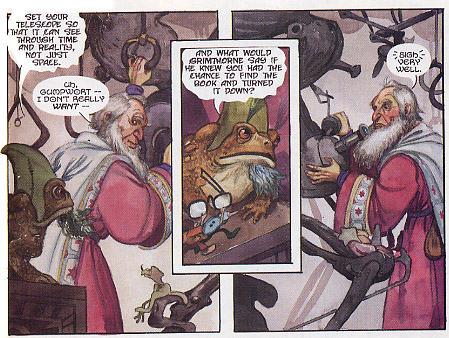
Kurt: cat wanted it sounded out, pointing out that you wouldn’t see it as dialogue in a novel. I pointed out that you didn’t see such things spelled out, either — you wouldn’t read someone saying, “Hhhh,” which was her version of a sigh. You’d get a sentence reading, “He sighed,” and this was the comics version of that. I rewrote every part of THE WIZARD’S TALE that had words like that in it to get rid of them, so I didn’t have to do it her way. Then, when we switched to Wildstorm, I put a bunch of ’em back.
Steven: But would a caption saying “He sighed.” be so wrong?
Kurt: Depending on the narrative style of the story, no, but I don’t see it as superior to “>sigh<” by any stretch.
In this particular story, there were only two captions — “Once upon a time…” at the beginning, and “…and they lived happily ever after” at the end. So it wouldn’t have worked there.
Mark: Thought balloons were the only thing that came to mind when the question came up, so I’m glad I asked — and I just used thought balloons in an upcoming SUPERMAN, and several one or two panel flashbacks, so these conventions clearly aren’t totally dead! — but they’ll pry SFX out of my cold, dead hands…
Besides, I’m not sure that a general stylistic evolution is necessarily abad thing, since our collective visual vocabulary is changing every day.Audiences are capable of accepting and processing way more information now,without being led by the nose. Wasn’t too long ago that movie grammar insisted that for audiences to understand how characters got from place to place, we had to see them exit, get in a car, drive, get out of the car and enter. And I’m not sure that novelistic conventions are any more valid than film conventions when it comes to the singular art form that is comics… In comics, third person narrative captions were often the comic-book equivalent of the car transition.
Kurt: Granted — but that just gets back to John Ostrander’s point about other people doing it badly.
Ma
rk: I’m not sure that novelistic conventions are any more valid than film conventions when it comes to the singular artform that is comics…
Kurt: I wouldn’t say so either — I’d say they’re both valid, as are advertising conventions, poetic conventions and more.
I think that too often, the bulk of comics creators all race off in the same direction, following the latest trend. I don’t think editors should be chivvying the others along, too, making sure they all limit themselves in the same way.
I like captionless comics, I like first-person narrative, I like third-person omniscient, third-person directed, shifting third-person directed, thought balloons, minimal captions, multiple first-person narrative tracks and more.
I want to have it all available, and use what tells the story best.
Steven: Right. You have to figure out what works for the particular story.
Trina Robbins: I use thought balloons in GoGirl!, and in the educational graphic novel series I’m currently working on, and will use them untilGeorge Bush declares it a punishable offense.
Marv Wolfman: It’s something that’s been bothering me for a long time. Ifeel too many people as they grow up are embarrassed by the comic book conventions. It’s as if by changing them they make them more mature.Well, put a guy in a Superman or Spider-Man costume and no matter how many or few captions you have it is by nature a little juvenile.
You can do stories that are well written and touch on adult themes but the essence is still wish fulfillment fantasy. And there’s nothing wrong with that.
But to be embarrassed by the specifics that make comics unique is ludicrous.There is nothing wrong with captions, thought balloons or even sound effects if the story calls for them. But then I think the majority of the people who make the decisions about such stuff are, as I say, probably embarrassed by the entire medium.
Tim Eldred: I’ve been following this topic with interest, since I’ve developed some opinions about them over the years as well.
Generally, I try to avoid thought balloons for one basic reason: I think it’s much more natural to keep the interplay entirely at the dialogue-and-body-language level. That, after all, is how we see other people interact in real life.
But comics aren’t real life, right? Every work of fiction is simply a contained viewpoint. Every medium has its own grab-bag of shortcuts. The choice of container dictates the ones you use. But when any of those shortcuts are used to excess, they call attention to the container itself,don’t they?
I think one reason people dump on thought balloons so much is that they were so heavily used in the past, particularly in the 60s and 70s. Let me toss out a speculation here, and maybe some of you can confirm or deny…
Back in the Marvel bullpen, when there wasn’t time to write a full script,the penciller was given a story outline, and it was his job to break this down into panels which would be scripted later. Once the penciller was done,the writer was basically stuck with those pictures. Naturally, there must have been many situations where a writer was looking for a nuance that was absent in the art, and provided it instead with words. And if the pose or expression didn’t support a particular bit of dialogue, then a thought balloon would be a sensible substitute.
Perhaps this practice got enough stories out of logjams that it soon became common to toss in all the thought balloons you wanted, and everyone simply got used to it.
Jump forward to later years, when scripts are fully written prior to pencilling, and writers continue to use thought balloons despite the opportunity that now exists to write more stage direction instead. Thus,lots of thought balloons where only a few are necessary.
Ditto sound effects? I dunno, just speculating…
John: Interesting. Most books were done plot first when I started. Today,many publishers want full script — and there are pros and cons to this as well — so, depending on who I’m working with, I might trust them to convey what I want conveyed with just body language and a look. But if its an artist I DON’T know as well, I’m a little more leery. When it’s plot first,I can play off what the artist does more. Full script — I don’t have that luxury. Not that there aren’t plenty of advantages going full script but hoping the artist will put in the body language when you don’t know them — ehhhh.
Like Kurt, I prefer to be allowed my full tool bag and not be denied something because of someone else’s THEORY. When Bob Layton over at Valiant restricted use of thought balloons, I asked him if he was willing to have me pick some of his brushes at random and tell him he couldn’t use them anymore. That didn’t work, either.
Marv: I really do think it’s an embarrassment issue because so many writers have decided that instead of third person omniscient narrator captions they do first person caps which is essentially thought balloons without bubbles. I think they feel that the bubbles make it look kiddy. Tome it’s those folk who insist they’re not trekkies but trekkers as if one dumb word is more mature than the other.
First person narration, which you find in almost 90% of detective novels, is just like thought balloons or first person captions.
Kurt: I don’t think so — I think another mistake that’s made is that so many people do think that first-person narrative and thought balloons are the same thing.
They’re similar, yes, but not quite the same. Narrative tends to be more considered, and that’s a distancing tool — it makes the reader feel more like an observer, less like they’ve got a sense of immediacy, of engagement in the material.
A narrative caption — “The razor-bats came at me. I ducked.” is “cooler” –and by that I mean less intense, not niftier — than a thought balloon reading, say, “Aaah! Razor-bats! Gotta duck–!”
They may carry the same information, but they affect the reader in a different way. The narrative caption is narrative — someone telling you a story, even if it’s present-tense — while the thought balloon is internalized dialogue — someone verbalizing things to himself, and we’re just eavesdropping.
That’s why the Punisher’s “war journal entry” caption narratives worked so well for him, but the same sort of thing works less well for Spider-Man.The Punisher is cool, distant, considered — he comes across as mysterious and methodical, and the reader observes more than engages. Spider-Man is all emotion, and you want that engagement.
You can, of course, simply write thought-balloons and put ’em in captions,but it’s not how they’re usually done, and it often reads strangely when it is done that way.
To expand on your suggestion that it’s embarrassment, I think this is a big part of it — that sense of engagement, of being “caught up” in a juvenile story, is what fuels the embarrassment, as much as or more than the shape of the thought balloons. It’s the distancing factor of narrative that makes it”sophisticated,” and thus perceived as less juvenile.
But distancing the reader isn’t the way to appeal to young readers. I don’t see anything wrong with a book aimed at 20-year-old readers having that distance; I think it’s a terrible idea for a book aimed at 10-year-olds.
Which may be a contributoring reason — as this sort of thing has taken holdover the last twenty-plus years — as to why there are so few books that successfully reach 10-year-olds.
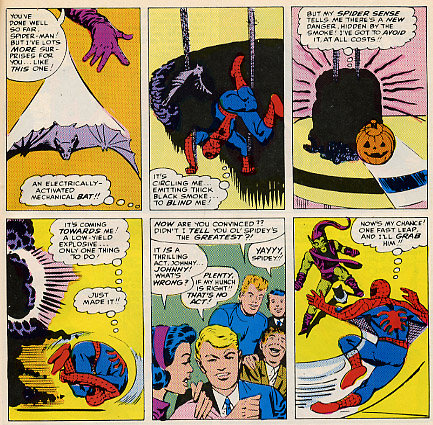
Marv: I do think thought balloons are very useful but, like everything, you should do them for the right reasons. When Spider-Man did it back in the 60sit was to show the difference between his physical actions and what was going through his mind at the time, the dichotomy is what made the charac
ter interesting.
On the other hand, I never used them with Dracula because I purposely didn’t want you to know what was in his thoughts. I wanted his actions to fight against what he said. I think having thought balloons lets you inside you character but they have to be done for the right reason, not to give info that could be done another way. Since we all have running commentaries inside our minds as we go about our daily lives, they are actually more a reflection of reality. Removing them simply because they’re reminiscent of kiddy comics is simply a case of throwing the baby out with the bathwater.
John: I completely agree on the difference in the first person narration vs thought balloon. When I’m doing GRIMJACK where we use a lot of first person narrative, I have to be careful I’m NOT doing thought balloons OR simply describing what you already see. GrimJack COMMENTS on the situation –giving thoughts AND feelings in a way that is very different from thought balloons. At least to me. I don’t often use thought balloons with GrimJack,in fact.
Steven: There were originally a lot of good reasons for curtailing many of those techniques, as most were overused and wrongly used mainly to dumb down the comics. The main function of thought balloons had become idiot exposition — Spider-Man swinging over Dr. Octopus beating up some cops and thinking, “That’s Dr. Octopus — beating up some cops!” But the thought balloon never really died, it just morphed into the first person narration caption, which is to some extent far more flexible. It’s one thing to haveThe Punisher pithily reflecting on his situation in a caption, another to have the same thing in a thought balloon, the latter being fairly idiotic under most circumstances; the narrative remove of the caption is what gives it effect. But way too many people have likewise reverted it to mere idiot exposition, which is the real bane of comics.
But many old, retired techniques are worth mining now for new possibilities.One I’ve fallen in love with, and am using in my “Weird Date” stories in THE ESCAPIST, is the illustrated narrative caption, which was common in ’50s love comics but will be familiar with anyone who read Carmine Infantino’s FLASH, ADAM STRANGE, BATMAN or science fiction stories of the ’60s: A usually narrow panel that’s pure narrative, except for one drawing that maintains some mood or movement, like a futuristic cityscape, or a lit candle in a candleholder, etc. It can be used as a great transitional gimmick, or to get a point, action or emotion across that doesn’t require a whole drawing, or to connote the passage of time. In my first ‘Weird Date’ story, for instance, my heroine was waiting in a restaurant for a date that has apparently stood her up, and the illustrated narrative panel in the scene shows a mostly empty wine bottle and two wine glasses, one with just a trace of wine in the bottom and the other knocked over. Without my having to spell it out, it got across not only the amount she had inadvertently drunk but the suggestion that enough time had passed for her to drink that much, and added, I think, to the overall emotional effect.
I wouldn’t want to see all these old practices come back wholesale in old forms, but maybe it’s time we recovered them to demonstrate not only what can be done right with them but to demonstrate that comics as a form AREN’T film, despite interconnections and similarities. I think we needed that period where comics became infected with film techniques, but now it’s time to go another step forward, now that we as a medium have had a few years to step back from them, it’s time to re-approach them with a fresh eye and figure out how to use them better and more creatively.
The thing about thought balloons in particular with a lot of editors is that they’re considered “juvenile” and “comic book” and they want their books to be perceived as rising above that.
I suddenly feel like doing a story told entirely in telepathy, so no one uses a single speech balloon… One of the great values of thought balloons is to establish and explore the dichotomy between what people say and what they think. If the story demands naturalistic presentation, then thought balloons are probably not the most appropriate technique.
More to the point, at least in my experience with “the Marvel method,” the thought balloon could be a useful tool for putting across elements thatSHOULD have been in the art but the artist didn’t seem fit to draw for some reason. Unfortunately, you’d end up with things like “That noise around the corner — that’s GOT to be the Hulk!” Though hopefully presented more artfully than that… Nuance was kind of a luxury under the Marvel method;just getting all the basics in was difficult enough…
Howard Cruse: Despite my misgivings — given that there’s no equivalent in any other literary medium that I can think of — I’ve stubbornly held onto boldfacing in word balloons as a tool for suggesting emphasis and cadence though not importance. Anytime I’ve thought of ditching them, I would think about how visually boring a block of text would become without those spots of black and have re-pledged my allegiance to interspersed boldface in all its hokey-ness.
Sometime during the mid-’80s I did become self-conscious about the old comics convention, which I had absorbed and adopted without much thought from my teenage years onward, of ending every sentence with an exclamation point. But by then I was midway through my Wendel series and, knowing that all the strips would probably be collected in a single book eventually, I resisted making a big change that would call attention to itself. Once I was finished with Wendel, though, the exclamation-point count in my stuff dropped drastically.
I rarely use thought balloons because they imply that characters could put their thoughts and motives into words if asked. My characters are often only hazily aware of their own motives, if that. I enjoy letting the reader wonder how much a character’s words or actions reflect their deepest inner beings.
I will give no ground on sound effects, though. They remain a dramatic tool for which there is no alternative in a soundless medium. They also help combat pretentiousness, since there’s no escaping the slight silliness of spelling out noises in vowels and consonants. These tools are like stage conventions that have no parallel in everyday life — like flying in new scenery or shifting the predominant color of lighting to reflect changes of mood — but have proven their value in propelling a story forward while audiences willingly suspend disbelief.
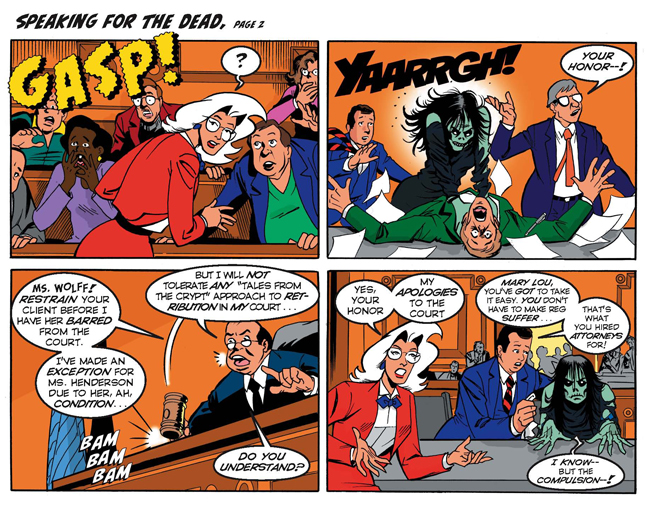
Jackie Estrada: Well said, Howard! Batton uses boldface ital and what he calls “tweaking” — using a different font — to emphasize certain words in word balloons, following the style Eisner established in THE SPIRIT. We also use sound effects in “Supernatural Law” for things like “Creeakk” to enhance the opening of door in a scary scene, or “CRASH” off-panel so that the on-panel folks stop and say “What was that?”
Kurt: I like that approach quite a bit — it feels more newspaper-strip than comic-book, to me, even in comics like CEREBUS. But I like that feel.
We’ve played with that approach here and there in CONAN — usually changing the font for a shouted balloon more than mixing fonts within a balloon, butI think we’ve done some of the latter, too.
And when I saw “we,” I mean, of course, “Richard.”
Bob Ingersoll: Since we’re discussing some lettering foibles we don’t like,Kurt, I’ll add one of my own — one that comes from one of your books.
I really don’t like lettering that calls attention itself, especially different fonts for different characters. I find that this device relieves the writer of trying to come up with distinct voices for the characters, as the d
istinction can be made from the different fonts. And this can — and often does — lead to lazy writing, where all the characters voices sound the same.
Kurt: I don’t like it when it overloads the book, but everyone’s “intrusive”level is going to be different.
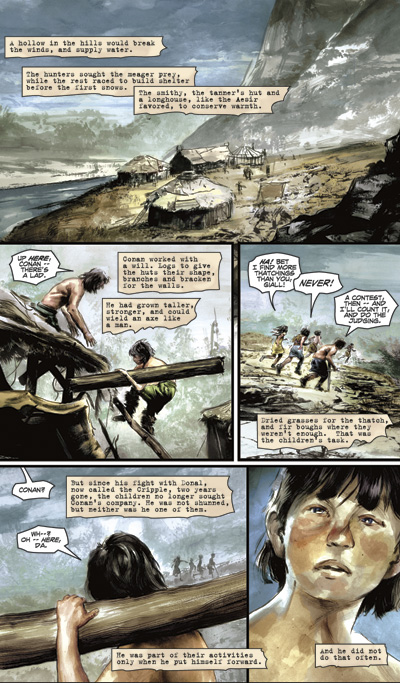
Bob: Another example of different fonts — and the one related to Kurt’s work — is the use of the old-style, courier font — complete with filled in”O”s — used in the captions in CONAN. While I know it’s an attempt to bring the feel of old-style pulp writing — by having the text boxes look as ifHoward typed them on an old manual typewriter that was in need of cleaning– it calls attention to the lettering itself. And, to be honest, I sometimes find the font hard to read; especially when I’m reading the comic on a moving bus during my commute. So, for all those reasons, I really don’t like that one font choice in CONAN.
Kurt: There are some readers who hate the captions in CONAN, and some who love ’em — luckily, the balance is pretty substantially on the “love ’em”side, or we’d stop. The look of them is Richard’s execution, but was my suggestion — I thought they’d give the book a distinctive flavor, and that they’d go really well with the look of the art, both Cary’s pencils andDave’s colors.
I also thought that such a pulp-flavored narrative, in today’s comics market, ran the risk of feeling “old school,” and didn’t think it’d work terribly well in straight, conventional captions. It just didn’t feel right to me, when I pictured it mentally. So we tried it, and everyone on the book liked it enough to go with it.
Harlan Ellison actually called Dark Horse to tell them to clean out the keys and get a new ribbon. He thought it was a real typewriter, and we just hadn’t noticed.
Bob: Doesn’t kill my enjoyment for the book. Just find that one choice not to my taste.
Kurt: No sweat. I like lettering to be simple and clear, most of the time,but I also like to try different approaches — there’s no reason the lettering approach in CONAN should be the same as in CAPTAIN AMERICA.
I don’t think P.T. Bridgeport-style balloons work well unless done comedically, but I think it worked great comedically. And the multiple styles in SANDMAN were restrained enough to work well for the tone of that book.
Bob: Oh, I agree. When I said I didn’t like lettering to be intrusive, it was more along the lines multiple font types in a single book, not different books having a different font style most suited to that book.
But most important is that the font should be readable — particularly to those of us plagued by the twin afflictions of aging, nearsighted, bifocal-corrected eyes which are reading things while on a bouncing, moving bus.
Rich: In British editorial circles exclamation marks are known as Screamers –What about exclamation marks on sfx? Yay or Nay?
Kurt: I used to put them in until Jim Salicrup told me not to. His reasoning, as I recall, was that they’re not speech and thus don’t get punctuated. I don’t know that I buy that argument, but I don’t care so much one way or the other, and now I leave ’em off just for consistency. It seemed like a useful rule to me so I use it.
But if I’m using FX lettering for something vocalized — like, say, Devil Dinosaur uttering a mighty HRRONNKK! — I’ll punctuate that, because it is speech.
Beyond that, it’s personal taste — I don’t much like multiple exclamation points, but that’s not an argument that they can’t work. Stan used the hell out of that key on his typewriter. It’s just individual preference, not stumping for a rule. I took all the exclamation points off the FX in the Conan spin-off Len Wein and I are co-writing, but that was largely because it’s a spin-off of a book I’m writing, one that uses my approach. Were I editing rather than co-writing, I’d leave ’em in — or were I co-writing a spin-off of a book Len was writing, I’d do it his way. As long as it works, it works. That’s what really matters.
Rich: Double exclamation marks in balloons? Triple exclamation marks? In comedies? In dramas?
Lee: WHAT???!!!
Kurt: Never liked them in any medium… but I think I’d be more open to them in a comedy.
Steve Lieber: Almost never, unless there are no words in the balloons. Worst of all is the use of multiple question marks at the end of a sentence: “Why are you going????” I can only read that as indicative of some sort of Parkinsonian quaver-stutter or Tourettic tic.
Howard: I disagree. The difference between one and two question marks is the difference between an inquiry and abject astonishment. Sparing usage of such devices, of course, is recommended.
Kurt: In those case, I tend to favor WHAT?! over WHAT?? But I can see the point.
Tony Isabella: In comedies, maybe. But, in drama, well, the exclamation mark denotes a forceful end to the statement. If the statement is ending in a question, but still forcefully, I’ll use “?!” for the ending.
Steven: My philosophy on SFX is that a few go a long way. You definitely need SFX when an off-panel action, like someone shooting a gun, is affecting what’s happening on panel; with, say, a prominent BLAM! it’s just a picture of someone gripping their chest and falling with a pained or shocked expression. The SFX is essential to understanding the scene. On the other hand, when the Howling Commandos are all charging forward firing machine guns, you don’t want to start filling up the panel with a BUDDA for every shot being fired because that’s just clutter and diminishes the overall effect, and only having one or two BUDDAs is underkill, so unless you’re going for overkill it’s arguably best to leave them out entirely. Too many people like to make up new sound effects — was it Len Wein who once had a thunder/lighting effect that went KRAKADOOM!? — and those can be distracting. I used to think familiar SFX like BLAM! were unimaginative, but now I think they’re really more unobtrusive, when used sparingly. We know BLAM! represents a gunshot, and used properly it and similar SFX can ratchet up the tension in a scene because the reader doesn’t really perceive them as a separate element; they blend in, like good coloring or lettering.
I’d like to see colons and semi-colons used regularly in comics, personally. I find it very useful, with bolding, to bold not specific words but specific syllables, so that, for instance, a character doesn’t say “really?” or “REALLY?” but “REAlly?” It’s all a matter of whether you want the dialogue to sound FANtastic! or fanTASTic!
Marv: Not only do I agree with using SFX, but I think it certainly hasn’t hurt the sales of Manga to older readers considering they have sound SFX for everything, including turning the head.
Trina: Sound effects are a major part of manga. In the course of my English language rewriting of manga for Viz, I’ve encountered some doozy Japanese sound effects that I’ve had to “Americanize” — Gaba, Doga, Kachi, Gushagusha, Jyaki — and I’m happy to say that several times I have been able to use “Krakadoom!”
Keith: Speaking of odd comics conventions… @#$#!!
For a time, @#$#!! was the preferred method of denoting curse words. Then it fell out of favor for some reason, and writers simply wrote PG dialogue, which is, to my mind, the best way of doing it, as the above always felt like I was watching bleeped dialogue on TV, a practice I have always despised. Now, however, it’s come back, except it’s just a “blackout” effect, like somebody crossed the curse word out with a Sharpie.
If you ask, I’m willing to bet real money — not a lot of it, but real money nonetheless — that the folks who use it and/or directed its use think that it’s more mature and “edgy,” where using odd symbolic characters is “car
toony.”
Except it isn’t. It’s the exact same %&#$% thing!”
Kurt: I always liked the typographic jumble — it’s got emotion and bounce, and gives a tone to the dialogue that I can “hear.” Admittedly, what I “hear” is more like “rassafrassin'” than like actual swearing, but it carries emotion well.
Better than bowdlerized dialogue — freakin’, mother-lovin’ buzzards! — and better than those blackout things you mention.
Bob: Well $#!+ so do I. I find the black squiggles silly-looking. And it just doesn’t seem right to have street criminals saying “Freaking” or “Sweet Christmas!”
Keith: A good example of doing it right is THE SHIELD. They use harsher language than network television, but they still have some restraints. So they have a heavy emphasis on s**t and goddamn and bitch and such, but no sign of f**k at all, nor even any variations on it. They just stick with what they can use instead of coming up with stupid synonyms.
Bob: One more point, that’s something that BATTLESTAR GALACTICA and FARSCAPE did, create their own swear words. When Chrichton said “Frelling” you just knew what he meant, even if the Hayes Commission did.
Rich: DROKK IT! What in the name of GRUD is wrong with made up swear words?They’re VARKING SCROTNIG.
Lovern: Who can forget “FRAG”?
Steve: I remain a lonely supporter of cropped SFX, and have used them fairly regularly since I first noticed them in Attilio Micheluzzi’s “Shanghai.” There’s something compelling in the way they straddle the line between a purely graphic element and readable text. I’ve found that I still get the beat in a panel that a typical sound effect offers, but it’s more…um…subliminal? I think that a reader is less aware that he has read a sound effect when it’s properly cropped, but still gets all the impact it would otherwise have.
And since there’s no reasonable way to objectively determine what inGod’s name would, in fact, constitute a properly cropped sound effect,I’ll note that an improperly cropped one typically reads like it’s coming from off panel.
Good lord. I just reread the above, and I realize that I am now officially the dorkiest man alive. Somebody should send over a tailor because I need to have all my pants re-hemmed up past the ankle.
Kurt: There’s a great cropped word balloon — not FX, but as long as we’re talking cursing — in an early LOVE AND ROCKETS — a young Hopey is shouting f**k YOU!, and it’s cropped in such a way that it brings across the idea that she’s being blocked, stifled.
I do indicate cropped FX every now and then, but they usually get uncropped somewhere along the way.
Trina: Actually, what annoys me just as much are all those Vertigo-type titles that feel they must prove they’re for grownups, so they throw in as many f**ks and s**ts — or, because they’re often British, shites and bollocks — as possible.
Keith: Maybe — but the one doesn’t preclude the other. The most literate, intelligent, thoughtful, complex television show on the air right now is DEADWOOD, where 95% of the characters curse a blue streak.
Bob: I’ve had the same reaction. Particularly the FURY mini from Marvel Max. Sweet Christmas, I don’t think there was a page that didn’t have the word f**k in it. And if there was, there were more than enough multi-f**k pages to keep up the average.
Just because you can do something, doesn’t mean you SHOULD do something.
Tony: Individual stylistic evolution… good.
General stylistic evolution… bad.
